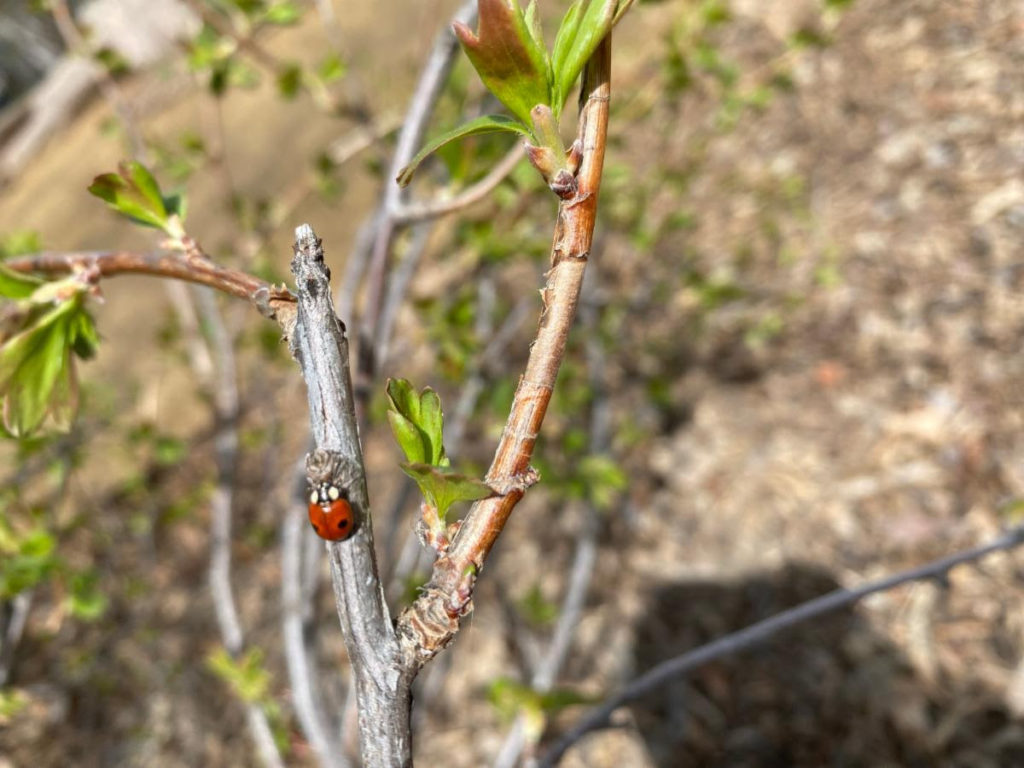This week started slow but ended in a flurry of activity when our staff ventured outside and found 4 species of lady beetle on a single plant – just outside the office. It just goes to show that even when activity seems slow, if you take a moment to slow down a look closely, you may find there’s more going on than you realize.

Common Water Strider (Aquarius remigis)
Striders are a common sight on ponds, quiet pools in streams, and even in Missoula canals. As true bugs (order Hemiptera) are predators and highly specialized for life on the water’s surface. These feather-light bugs exploit surface tension to stay afloat; evenly distributing their weight with their long legs, and repelling water with thousands of hydrophobic hairs on their legs and body.
Brenna Shea, April 25th, 2023. Rattlesnake Recreation Area, Missoula, MT.
Common Green Lacewing (Chrysoperla sp.)
This is our second green lacewing sighting this year, but this one is showing off the colors that lend to its common name. While these beautiful and delicate looking insects are harmless to humans, they are very capable predators that always seem to be hungry. The larvae are called “aphid lions,” and will occasionally pile the carcasses of their victims on their backs or cover themselves with other debris in order to camouflage themselves.
Brenna Shea, April 27th, 2023. Missoula, MT.


Becker’s White (Pontia beckerii)
This butterfly sighting was a pleasant surprise, given the slow start we’ve had this spring. This species, also referred to a sagebrush white, is found in arid, open habitat in the western United States and southern Canada. P. beckerii is associated with several plants in the mustard family, and seen throughout spring, summer and early fall (though it seems to be most abundant in early spring).
Connie Geiger, April 23rd, 2023. Scratchgravel Hills, Helena, MT.
Stone Centipede (Lithobiomorpha)
In early spring, when insect activity is still getting off the ground, you can always turn over a log to find an explosion of activity. Stone centipedes are a common sight in these bustling mini-ecosystems; they are fast, agile, and venomous predators. While their venom is not medically significant, they are still capable of giving humans a good pinch, so always be sure to handle with caution.
Brenna Shea, April 25th, 2023. Missoula, MT.


Asian Lady Beetle (Harmonia axyridis)
This species of lady beetle was introduced to the US in the early 1900’s to help control aphids. Unfortunately, they are an aggressive species that has since established and has an impact on our native lady beetles. Their color can range from light orange to deep red with the boldness of the spots / patterns being different from individual to individual. The top of the thorax is often pale, with a M-shaped dark spot, but in dark forms it can be black with white outer edges.
Brenna Shea, April 27th, 2023. Missoula, MT.
Western Polished Lady Beetle (Cycloneda polita)
This blood red beetle certainly looks like it has been polished to a shine. As the name suggests, this species ranges across the west—in the Pacific Northwest, south to southern California and down the Rockies down to New Mexico. Like most other members of the subfamily Coccinellinae, these beetles feast on insects and insect eggs, including aphids and other “true bugs” (suborder Heteroptera), caterpillars, fly larvae, and scale insects. As such, they are excellent garden companions.
Brenna Shea, April 27th, 2023. Missoula, MT.


Cream-spotted Lady Beetle (Calvia quatuordecimguttata)
Despite its name, the cream-spotted lady beetle comes in a wide variety of color morphs, including the form seen here with large black spots. The name stems from the Eurasian color morph, which exhibits – you guessed it – cream-colored spots. This species is widespread across Europe and Asia, and is an introduced species to North America.
Brenna Shea, April 27th, 2023. Missoula, MT.
Two-spotted Lady Beetle (Adalia bipunctata)
Two-spotted lady beetles are native to both North America and Europe. As another aphid predator, this lady beetle is often competing with introduced lady beetle species for resources, and has sadly such has disappeared from much of its North American range. We were thrilled to find two thriving individuals on this gooseberry, along with another native species, the western polished lady beetle.
Brenna Shea, April 27th, 2023. Missoula, MT.


Orange-legged Furrow Bees (Halictus rubicundus)
If you’re out looking for bugs and nothing seems to be active, you can always count on a sweat bee to be perched on a dandelion. They sometimes sting if disturbed, though the sting is not very painful. The Schmidt Pain Index describes their sting as “light, ephemeral, almost fruity. As if a tiny spark has singed a single hair on your arm.”
Brenna Shea, April 27th, 2023. Missoula, MT.
Tiger Moth (Apantesis sp.)
We believe this to be Apantesis virgo, the Virgin Tiger Moth, though even as adults, identifying Apantesis to species can be difficult. The adult moths take wing in summer, and are a sight to behold. While the caterpillar may look somewhat drab, adult tiger moths in this genus display stunning black-and-white patterning; though being nocturnal, you may have to stay up late to see them.
Connie Geiger, April 23rd, 2023. Scratchgravel Hills, Helena, MT.
